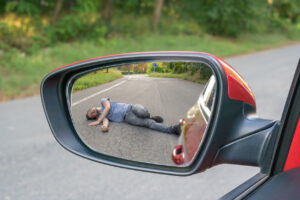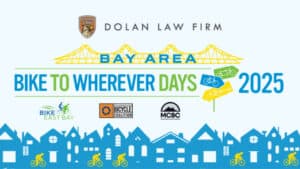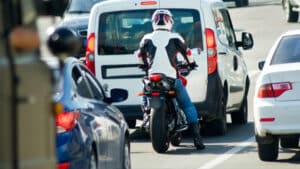
Jane in San Rafael asks: “I am an avid bicyclist and supporter of the Marin and San Francisco Bike Coalitions. It is frightening to ride on city streets. Last week there was a DUI-related fatality in Marin and another bike death in Windsor. What does the law do to punish people that kill bicyclists? Maybe letting readers know of the penalties might help them think twice and prevent more of these deaths.”
Jane, as a supporter of the Marin, Oakland, and San Francisco Bike Coalitions who rides with his children, I am horrified to see the increase in injury and death occurring in the cycling community. I am intimately familiar with the case in Windsor: we have been retained to represent the family of the young woman who was killed by a large truck. The Marin case, involving the drunk driver, is very tragic: people ruining their own lives by drinking is a shame, and when they kill innocent people on top of that, it’s criminal.
According to the National Highway Traffic Safety Administration, 3602 people were killed in California motor vehicle collisions in 2017. The majority of fatal collisions involve more than one vehicle and other vehicle occupants are the most likely victims of fatal collisions, followed by pedestrians, motorcyclists, and bicyclists. Thirty-one percent of these involved at least one driver with a blood alcohol level above the legal limit and 20 percent involved a driver with at least twice the legal limit. California Vehicle Code 23152 makes it unlawful for a person who is under the influence of any alcoholic beverage or drug to drive a vehicle while intoxicated, which is presumed at a blood alcohol level of 0.08 percent or greater, by weight. Commercial drivers, and drivers carrying passengers in exchange for compensation (taxis, Uber, Lyft, etc.) are presumed to be intoxicated if they have a blood alcohol level of .04 percent or greater.
Accidental deaths caused by motor vehicles generally fall under the rubric of vehicular manslaughter. California Penal Code (CPC) Section 192(c) defines vehicular manslaughter as the unlawful killing of a human being while: (1) driving a vehicle in the commission of an unlawful act (not a felony); or (2) driving a vehicle in the commission of a lawful act which might produce death in an unlawful manner. Vehicular manslaughter may be committed with or without gross negligence, defined as so slight a degree of care as to raise a presumption of a conscious indifference to the consequences. Causing death while perpetrating an accident insurance scheme, where the vehicular collision was knowingly caused for financial gain, may also be tried as either vehicular manslaughter or murder. If the driver is acting lawfully in a lawful manner, a resulting death is not considered a homicide.
According to CPC Section 193, the sentencing and punishment for vehicular manslaughter depends upon whether the offense is charged as a misdemeanor or felony. A misdemeanor vehicular manslaughter conviction is punishable by up to one year in county jail. A felony vehicular manslaughter conviction is punishable by up to six years in state prison. We recently handled a case on Highway 680 where a slow-moving construction crane, without its lights on and without warning or guides, entered the freeway from a staging area directly into 65 mile per hour traffic, causing death when another driver collided into the rear of the crane. In that case, the defendant crane driver plead no contest to vehicular manslaughter and was subject to a year of house arrest. The driver and the insurance company representing the business paid many millions to compensate the family for the loss of their husband and father.
Cases where the driver was intoxicated often command more severe penalties under CPC Section 191.5 defining “gross vehicular manslaughter while intoxicated.” Gross vehicular manslaughter while intoxicated, if committed without malice, is punishable by imprisonment in the state prison for up to four years; with malice, for up to 10 years. A person with one or more prior convictions of drunk or reckless driving who causes a fatality is subject to imprisonment in state prison for a term of 15 years to life. Gross vehicular manslaughter while intoxicated may be charged even if the driver’s blood alcohol level does not exceed the legal limit, as well as when an impaired driver is not the sole cause of death. In one case, a man with a blood alcohol level of .03 percent was traveling late at night on his way home from a concert, proceeded to fall asleep and rear-ended a car. After the initial accident, the occupants were able to get safely to the shoulder, but a truck driver, not paying attention, swerved to avoid collision with the car and killed the passenger of one of the vehicles. The impaired driver who caused the initial collision was charged with gross vehicular manslaughter while intoxicated.
Finally, if the driver’s conduct rises to a such level of wantonness as to support a finding of “implied malice,” it may be prosecuted as second degree murder. “Malice” is the mental state that distinguishes manslaughter, caused by the perpetrator’s criminal negligence, from murder, in which the perpetrator either intends to kill or acts deliberately with conscious disregard for human life despite knowledge that their conduct is dangerous. The California Supreme Court, in its seminal 1981 decision, People v. Watson, held that the statutory language crafted specifically for vehicular manslaughter does not preclude a charge of second degree murder where a perpetrator exhibited subjective appreciation of a high degree of risk to human life. In that case, the defendant had driven over 80 miles per hour in a 35 mile per hour zone with more than twice the legal blood alcohol level. When a driver willfully consumes alcohol to the point of intoxication, knowing that they will later operate a motor vehicle, they can be held to exhibit a conscious disregard for human life. The capability of the intoxicated driver to form malice in the act of reckless driving may later be evaluated with respect to a diminished capacity defense.
The vehicular homicide cases I have handled have involved people from all races and socioeconomic backgrounds. The law doesn’t discriminate between a rich guy driving a Porsche and a poor laborer driving a beat-up pickup truck. District Attorneys have little sympathy for drunks or unlawful drivers who cause harm or death. I hope that anyone reading this will refrain from driving even if they have had “only a couple of beers.” My heart and prayers go out to the families of the bicyclists who have been so senselessly killed.










